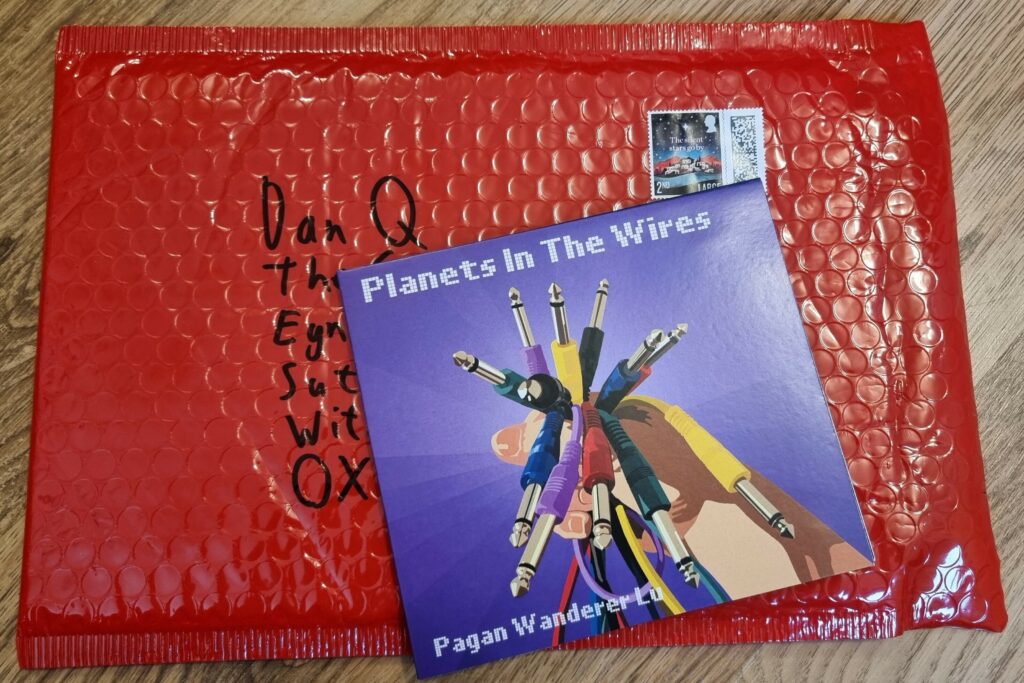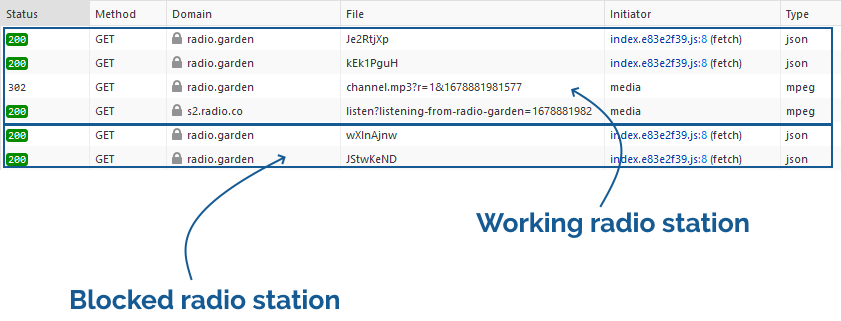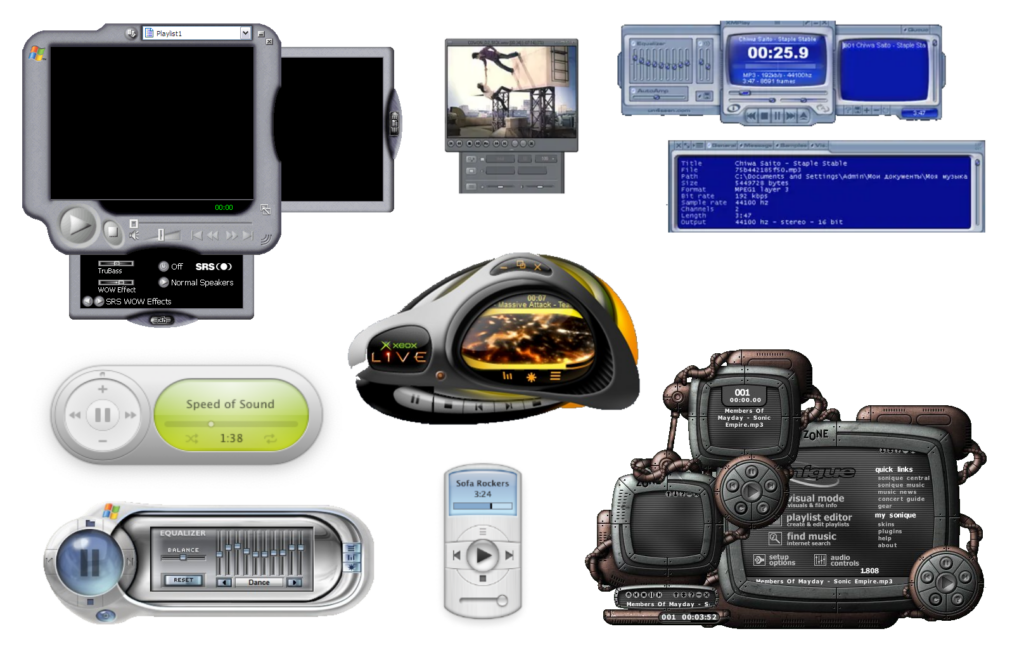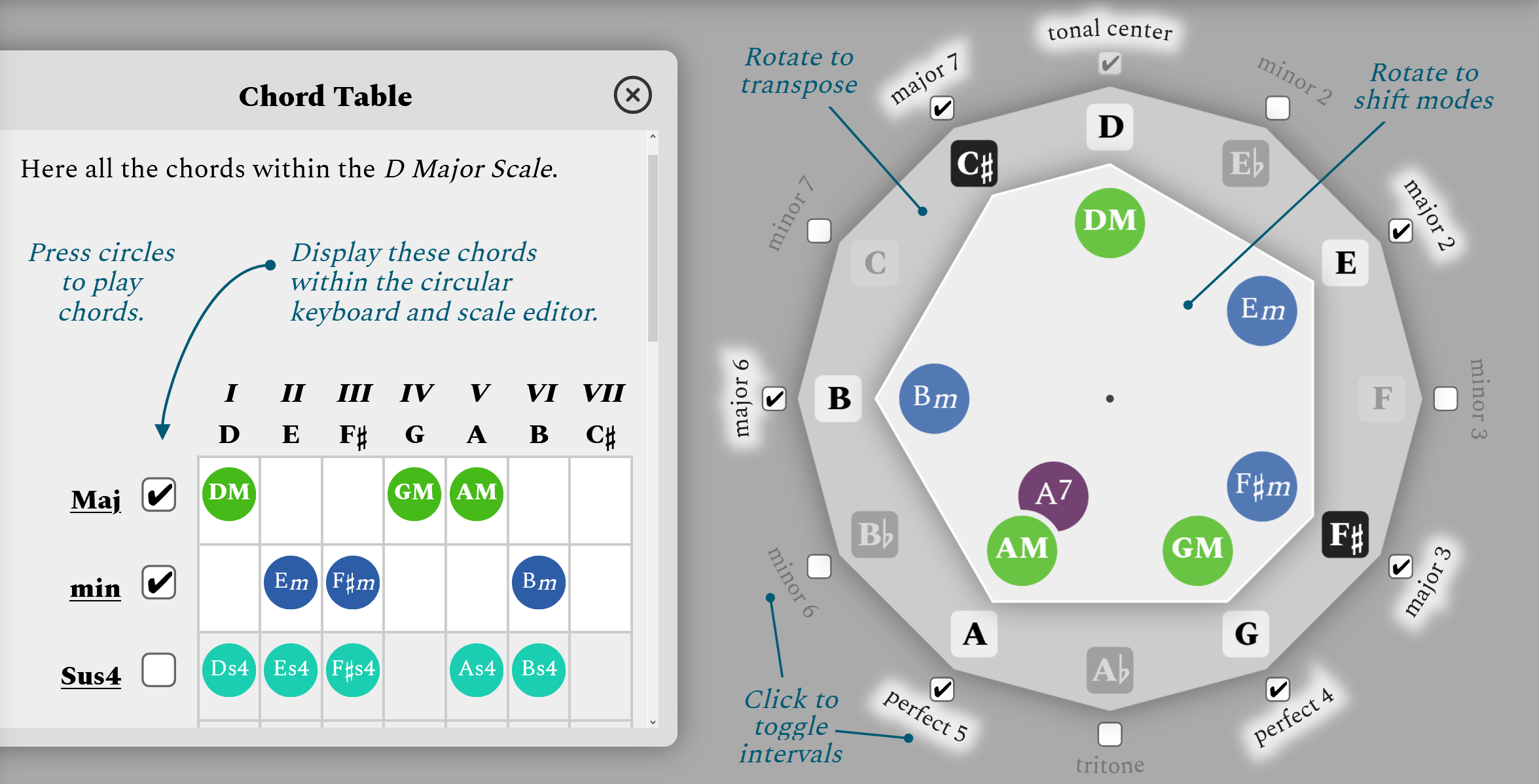I saw a variation of this email back in the day, which provides a Mad Libs style approach to formulating a country & western song. When I was reminded of it today, I adapted it for Perchance. Give it a go!
Tag: music
AI isn’t useless. But is it worth it?
This article is a repost promoting content originally published elsewhere. See more things Dan's reposted.
Molly White writes, more-eloquently than I would’ve, almost-exactly my experience of LLMs and similar modern generative AIs:
…
I, like many others who have experimented with or adopted these products, have found that these tools actually can be pretty useful for some tasks. Though AI companies are prone to making overblown promises that the tools will shortly be able to replace your content writing team or generate feature-length films or develop a video game from scratch, the reality is far more mundane: they are handy in the same way that it might occasionally be useful to delegate some tasks to an inexperienced and sometimes sloppy intern.
…
Very much this.
I’ve experimented with a handful of generative AIs, such as:
- GPT-3.5 / ChatGPT, for proofreading, summarisation, experimental rephrasing when writing, and idea generation. I’ve found it to be moderately good at summarisation and proofreading and pretty terrible at producing anything novel without sounding completely artificial and/or getting lost in a hallucination.
- Bing for coalescing information. I like that it cites its sources. I dislike that it somehow still hallucinates. I might use it, I suppose, to help me re-phase a search query where I can’t remember the word I’m looking for.
- Stable Diffusion for image generation. I’ve found it most-useful in image-to-image mode, for making low-effort concept art in bulk. For example, when running online roleplaying games for friends I’ve fed it an image of, say, a skeleton warrior and asked it to make me a few dozen more in a similar style, so as to provide a diverse selection of distinct tokens1. Its completely-original2 work lands squarely in the uncanny valley, though.
- Github Copilot for code assistance. I’ve not tried its “chat”-powered functionality but I quite enjoy its “autocomplete” tool. When I’m coding and I forget the syntax of the command I’m typing, or need to stop and think for a moment about “what comes next”, it’s often there with the answer. I’ve even made us of the “write the comment describing what the code will do, let Copilot suggest the code for you” paradigm (though I’ve been pretty disappointed with the opposite approach: it doesn’t write great comments!). I find Copilot to be a lot like having an enthusiastic, eager-to-please, very well-read but somewhat naive junior programmer sitting beside me. If I ask them for some pairing assistance, they’re great, but I can’t trust them to do anything that I couldn’t do for myself!
- Surely others besides that I’ve since forgotten.
Most-recently, I’ve played with music-making AI Suno and… it’s not great.. but like all these others it’s really interesting to experiment with and think about. Here: let me just ask it to write some “vocal trance europop about a woman called Molly; Molly has a robot friend who is pretty good at doing many tasks, but the one thing she’ll never trust the robot to do is write in her blog” –
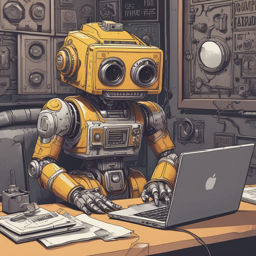
[Verse]
Molly’s got a robot that she keeps by her side
It’s pretty handy
It can do many things right
But there’s one task she won’t let it touch
It’s true
The robot can’t write in her blog
No
That won’t do
[Verse 2]
This robot can clean the house
Sweep it up real nice
It can even cook a meal
Add some spice
But when it comes to sharing her thoughts on the screen
Molly won’t trust the robot
That’s her routine
[Chorus]
Molly’s robot friend
By her side all day and night
There’s one thing it can’t do
Can’t write her blog right
She’ll keep typing away
Sharing her heart and soul
That’s something the robot can’t do
It has no control
So yes, like Molly:
- I’m absolutely a believer than these kinds of AIs have some value,
- I’ve been reluctant and slow to say so because they seem to be such a polarising issue that it’s hard to say that you belong to neither “camp”,
- I’m not entirely convinced that for the value they provide they’ve yet proven to be worth their cost, and I’m not certain that for general-purpose generation they will be any time soon, and
- I’ve never used AI to write content for my blog, and I can’t see that ever changing.
It’s still an interesting field to follow-along with. Stuff like Sora from OpenAI and VASA-1 from Microsoft are just scary (the latter seems to have little purpose other than for misinformation-generation3!), but the genie’s out of the bottle now.
Footnotes
1 Visually-distinct tokens adds depth to the world and helps players communicate with one another: “You distract the skinny cultist, and I’ll try to creep up on the ugly one!”
2 I’m going to gloss right over the question of whether or not these tools are capable of creating anything truly original. You know what I mean.
3 Gotta admit though that I laughed like a drain at the Mona Lisa singing along with Anne Hathaway’s Lil’ Wayne Style Paparazzi Rap. If you’ve not seen the thing I’m talking about, go do that now.
Young Squirrel Talking About Himself
This article is a repost promoting content originally published elsewhere. See more things Dan's reposted.
This week, Parry Gripp and Nathan Mazur released Young Squirrel Talking About Himself.
You might recognise the tune (and most of the words) from an earlier Parry Gripp song. The original video for the older version is no longer available on his channel, and that’s probably for the best, but I was really pleased to see the song resurrected in this new form because it’s fabulous. I’ve been singing it all day.
[Bloganuary] Landslide
This post is part of my attempt at Bloganuary 2024. Today’s prompt is:
What do you enjoy doing most in your leisure time?
Boo to this prompt! This Bloganuary already asked me how I like to play and about five things I do for fun; now it wants me to choose the thing I “enjoy most” from, presumably, that same set.
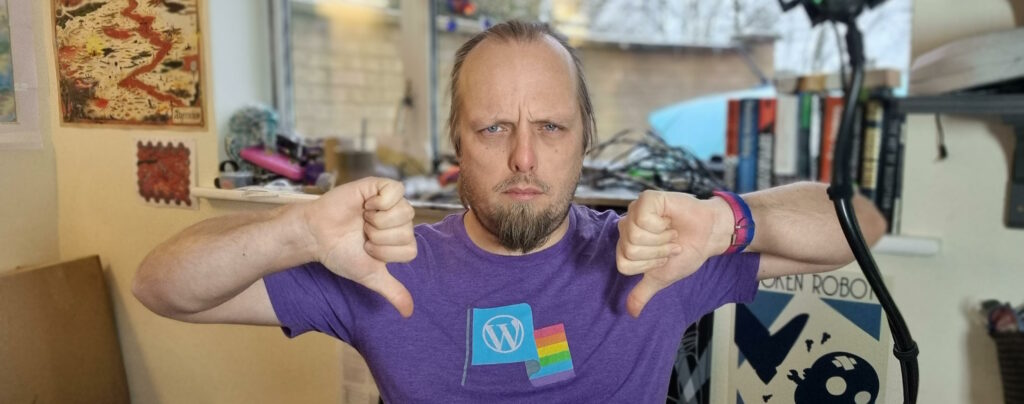
So I’m going to ignore this prompt.1 Instead, let’s go look up last year’s prompt from the same day:2
What is a song or poem that speaks to you and why?
Much better.
Landslide, by Fleetwood Mac.
At 5½ years older than me, the song’s been in my life effectively forever. But its themes of love and loss, overcoming naivety, growing up and moving on… have grown in significance to and with me as I’ve grown older. And to hear Stevie Nicks speak about it, it feels like it has for her as well, which just doubles the feeling it creates of timeless relevance.
In concert, Nicks would often dedicate the song to her father, which lead to all manner of speculation about the lyrics being about the importance of family. And there’s definitely an undertone of that in there: when in 2015 she confirmed that it was about a challenging moment of decision in her youth in which she was torn between continuing to try to “make it” as a musical act with her then-partner Lindsey Buckingham or return to education. Her father was apparently supportive of either option but favoured the latter.
Ultimately she chose the former and it worked out well for her career… although of course the pair’s romantic relationship eventually collapsed. And so the song’s lyrics, originally about indecision, grow into a new interpretation: one of sliding doors moments, of “what ifs”. In some parallel universe Stevie Nicks dropped out of Buckingham Nicks before Keith Olsen introduced Lindsey Buckingham to Mick Fleetwood, and we’d probably never have heard Landslide.3
Stevie still sings Landslide in concert, and now it feels like it’s entered its third life and lends itself a whole new interpretation. Those lyrics about turning around and looking back, which were originally about reconsidering the choices you made in your youth and the path you’d set yourself on, take on a whole new dimension when sung by somebody as they grow through their 60s and into their 70s!
In particular, coming to the song as a parent4 is a whole other thing. Its thoughts on innocence and growing-up, and watching your children do so, reminds me of my perpetual struggle with comparing myself to the best parent I know. An intergenerational effort to be my best me; to look forwards with courage and backwards with compassion for myself.
All of which is pretty awesome for a song that under other circumstances might be just a catchy twist on a classic country rock chord progression with some good singing. Sliding doors, eh?
Footnotes
1 It’s my damn blog; I can do what I want.
2 This is my first year doing Bloganuary, so I didn’t get to answer this prompt last time around.
3 Nor, for that matter, any of the other excellent songs that came out of Nicks’ and Buckingham’s strained relationship, such as Silver Springs, Second Hand News and, perhaps most-famously, Go Your Own Way. I guess sometimes you need the sad times to make the best art.
4 Nicks, of course, famously isn’t a parent, but I refer you to a 2001 interview in which she said “No children, no husband. My particular mission maybe wasn’t to be a mom and a wife. Maybe my particular mission was to write songs to make moms and wives feel better.”.
FreeDeedPoll.org.uk, Punk Rock Edition
A Birmingham-based punky trio, Luxury Nan Smell, have released an EP called (Derogatory). The first track on that album? freedeedpoll.org.uk. Named in reference to my website of the same name.
Naturally, I was delighted, not least because it gives me an excuse to use the “deed poll” and “music” tags simultaneously on a post for the first time.
Don’t ask me what my “real” name is,
I’ve already told you what it was,
And I’m planning on burning my birth certificate.
The song’s about discovering and asserting self-identity through an assumed, rather than given, name. Which is fucking awesome.
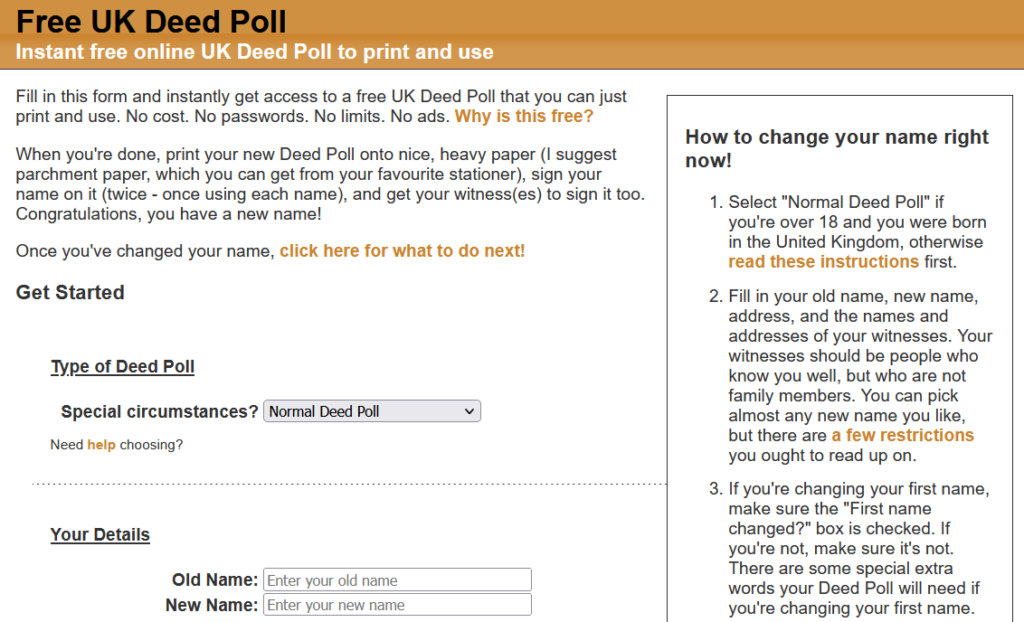
Like virtually all of my sites, including this one, freedeedpoll.org.uk deliberately retains minimal logs and has no analytics tools. As a result, I have very little concept of how popular it is, how widely it’s used etc., except when people reach out to me.
People do: I get a few emails every month from people who’ve got questions1, or who are having trouble getting their homemade deed poll accepted by troublesome banks. I’m happy to help them, but without additional context, I can’t be sure whether these folks represent the entirety of the site’s users, a tiny fraction, or somewhere in-between.
So it’s obviously going to be a special surprise for me to have my website featured in a song.
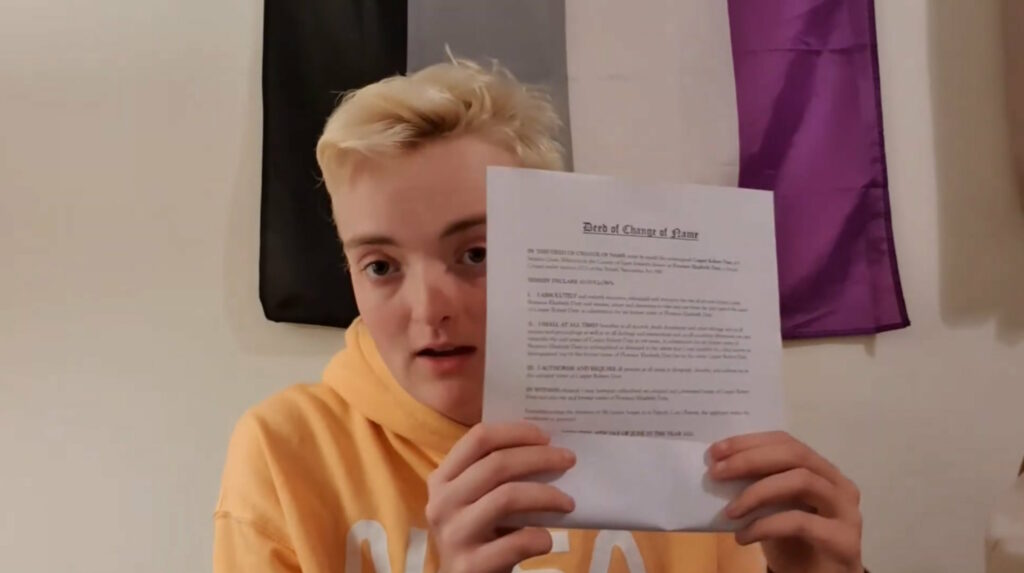
I’ve been having a challenging couple of weeks2, and it was hugely uplifting for me to bump into these appreciative references to my work in the wider Internet.
Footnotes
1 Common questions I receive are about legal gender recognition, about changing the names of children, about changing one’s name while still a minor without parental consent, or about citizenship requirements. I’ve learned a lot about some fascinating bits of law.
2 I’ve been struggling with a combination of the usual challenges at this time of year and a lack of self-care and also a handful of bonus household stresses: everything seems to be breaking all at once!
Tension in the Wires
Received my physical copy of Planets In The Wires today, and I must say it was really cool of Pagan Wanderer Lu to include one of Fred “Thickie” Holden’s famous Tension Sheets as a freebie.
The Frosted Pane
Pagan Wanderer Lu‘s new album Planets In The Wires dropped today, and I just cried my eyes out at track 5 (The Frosted Pane).
It opens almost apologetically, like an explanation for the gap in new releases for most of the twenty-teens. But it quickly becomes a poetic exploration of a detached depression of a man trapped under the weight of the world. It’s sad, and beautiful, and relatable.
Weird A.I. Yankovic, a cursed deep dive into the world of voice cloning
This article is a repost promoting content originally published elsewhere. See more things Dan's reposted.
In the parallel universe of last year’s Weird: The Al Yankovic Story, Dr. Demento encourages a young Al Yankovic (Daniel Radcliffe) to move away from song parodies and start writing original songs of his own. During an LSD trip, Al writes “Eat It,” a 100% original song that’s definitely not based on any other song, which quickly becomes “the biggest hit by anybody, ever.”
Later, Weird Al’s enraged to learn from his manager that former Jackson 5 frontman Michael Jackson turned the tables on him, changing the words of “Eat It” to make his own parody, “Beat It.”
Your browser does not support the video tag.This got me thinking: what if every Weird Al song was the original, and every other artist was covering his songs instead? With recent advances in A.I. voice cloning, I realized that I could bring this monstrous alternate reality to life.
This was a terrible idea and I regret everything.
…
Everything that is wrong with, and everything that is right with, AI voice cloning, brought together in one place. Hearing simulations of artists like Michael Jackson, Madonna, and Kurt Cobain singing Weird Al’s versions of their songs is… strange and unsettling.
Some of them are pretty convincing, which is a useful and accessible reminder about how powerful these tools are becoming. An under-reported story from a few years back identified what might be the first recorded case of criminals using AI-based voice spoofing as part of a telephone scam, and since then the technology needed to enact such fraud has only become more widely-available. While this weirder-than-Weird-Al project is first and foremost funny, for many it foreshadows darker things.
Batman’s World
I do not claim to have a good explanation nor excuse. See also this terrible idea from 21 years ago.
Bypassing Region Restrictions on radio.garden
I must be the last person on Earth to have heard about radio.garden (thanks Pepsilora!), a website that uses a “globe” interface to let you tune in to radio stations around the globe. But I’d only used it for a couple of minutes before I discovered that there are region restrictions in place. Here in the UK, and perhaps elsewhere, you can’t listen to stations in other countries without using a VPN or similar tool… which might introduce a different region’s restrictions!
How to bypass radio.garden region restrictions
So I threw together a quick workaround:
- Ensure you’ve got a userscript manager installed (I like Violentmonkey, but there are other choices).
- Install this userscript; it’s hacky – I threw it together in under half an hour – but it seems to work!
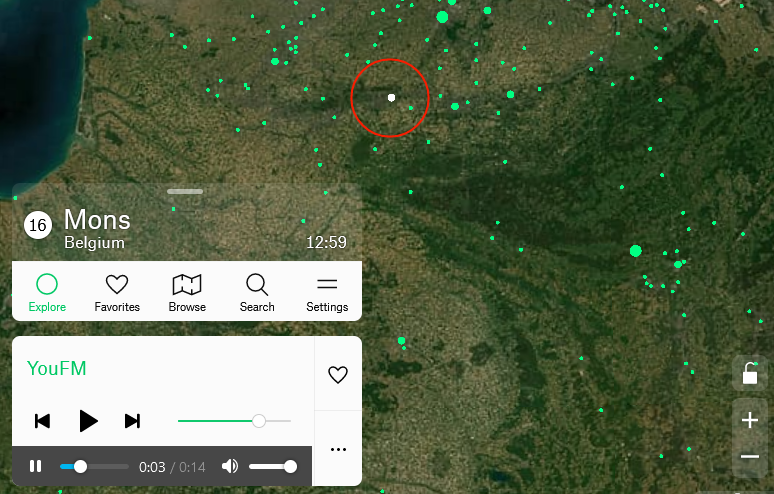
How does this work and how did I develop it?
For those looking to get into userscripting, here’s a quick tutorial on what I did to develop this bypass.
First, I played around with radio.garden for a bit to get a feel for what it was doing. I guessed that it must be tuning into a streaming URL when you select a radio station, so I opened by browser’s debugger on the Network tab and looked at what happened when I clicked on a “working” radio station, and how that differed when I clicked on a “blocked” one:
When connecting to a station, a request is made for some JSON that contains station metadata. Then, for a working
station, a request is made for an address like /api/ara/content/listen/[ID]/channel.mp3. For a blocked station, this request isn’t made.
I figured that the first thing I’d try would be to get the [ID] of a station that I’m not permitted to listen to and manually try the URL to see if it was actually blocked, or merely not-being-loaded. Looking at a working station, I first found the ID in the
JSON response and I was about to extract it when I noticed that it also appeared in the request for the
JSON: that’s pretty convenient!
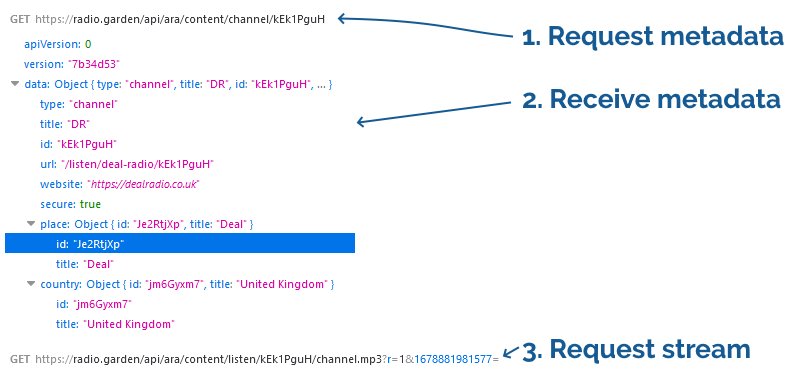 My hypothesis was
that the “blocking” is entirely implemented in the front-end: that the JavaScript code that makes the pretty bits work is looking at the “country” data that’s returned and using that to
decide whether or not to load the audio stream. That provides many different ways to bypass it, from manipulating the JavaScript to remove that functionality, to altering the
JSON response so that every station appears to be in the user’s country, to writing some extra code that intercepts the
request for the metadata and injects an extra audio player that doesn’t comply with the regional restrictions.
My hypothesis was
that the “blocking” is entirely implemented in the front-end: that the JavaScript code that makes the pretty bits work is looking at the “country” data that’s returned and using that to
decide whether or not to load the audio stream. That provides many different ways to bypass it, from manipulating the JavaScript to remove that functionality, to altering the
JSON response so that every station appears to be in the user’s country, to writing some extra code that intercepts the
request for the metadata and injects an extra audio player that doesn’t comply with the regional restrictions.
But first I needed to be sure that there wasn’t some actual e.g. IP-based blocking on the streams. To do this, first I took the
/api/ara/content/listen/[ID]/channel.mp3 address of a known-working station and opened it in VLC using Media
> Open Network Stream…. That worked. Then I did the same thing again, but substituted the [ID] part of the address with the ID of a “blocked” station.
VLC happily started spouting French to me: the bypass would, in theory, work!
Next, I needed to get that to work from within the site itself. It’s implemented in React, which is a pig to inject code into because it uses horrible identifiers for
DOM elements. But of course I knew that there’d be this tell-tale fetch request for the station metadata that I
could tap into, so I used this technique to override the native fetch method and
replace it with my own “wrapper” that logged the stream address for any radio station I clicked on. I tested the addresses this produced using my browser.
window.fetch = new Proxy(window.fetch, { apply: (target, that, args)=>{ const tmp = target.apply(that, args); tmp.then(res=>{ const matches = res.url.match(/\/api\/ara\/content\/channel\/(.*)/); if(matches){ const stationId = matches[1]; console.log(`http://radio.garden/api/ara/content/listen/${stationId}/channel.mp3`); } }); return tmp; }, });
That all worked nicely, so all I needed to do now was to use those addresses rather than simply logging them. Rather that get into the weeds reverse-engineering the built-in
player, I simply injected a new <audio> element after it and pointed it at the correct address, and applied a couple of CSS tweaks to make it fit in nicely.
The only problem was that on UK-based radio stations I’d now hear a slight echo, because the original player was still working. I
could’ve come up with an elegant solution to this, I’m sure, but I went for a quick-and-dirty hack: I used res.json() to obtain the body of the metadata response… which
meant that the actual code that requested it would no longer be able to get it (you can only decode the body of a fetch response once!). radio.garden’s own player treats this as an
error and doesn’t play that radio station, but my new <audio> element still plays it perfectly well.
It’s not pretty, but it’s functional. You can read the finished source code on Github. I don’t anticipate that I’ll be maintaining this script so if it stops working you’ll have to fix it yourself, and I have no intention of “finishing” it by making it nicer or prettier. I just wanted to share in case you can learn anything from my approach.
Why Did Media Players Look Like That?
You don’t really see it any more, but: if you downloaded some media player software a couple of decades ago, it’d probably appear in a weird-shaped window, and I’ve never understood why.
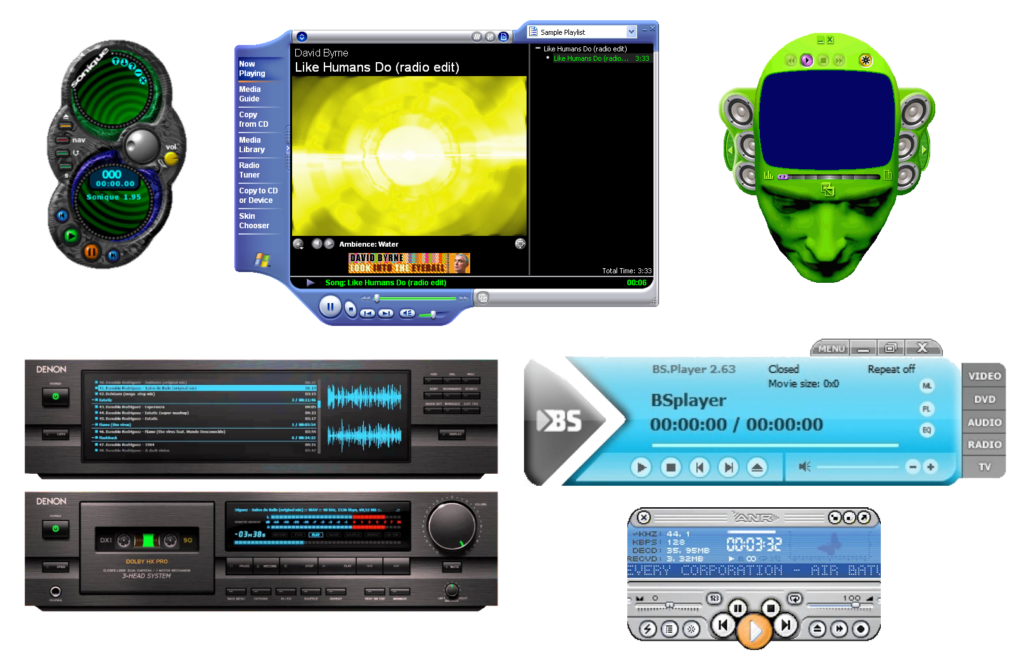 Mostly, these designs are… pretty ugly. And for what? It’s also worth noting that this kind of design can be found in all kinds of applications, in media players that
it was almost ubiquitous.
Mostly, these designs are… pretty ugly. And for what? It’s also worth noting that this kind of design can be found in all kinds of applications, in media players that
it was almost ubiquitous.
You might think that they’re an overenthusiastic kind of skeuomorphic design: people trying to make these players look like their physical analogues. But hardware players were still pretty boxy-looking at this point, either because of the limitations of their data storage1. By the time flash memory-based portable MP3 players became commonplace their design was copying software players, not the other way around.
So my best guess is that these players were trying to stand out as highly-visible. Like: they were things you’d want to occupy a disproportionate amount of desktop space. Maybe other people were listening to music differently than me… but for me, back when screen real estate was at such a premium2, a music player’s job was to be small, unintrusive, and out-of-the-way.

It’s a mystery to me why anybody would (or still does) make media player software or skins for them that eat so much screen space, frequently looking ugly while they do so, only to look like a hypothetical hardware device that wouldn’t actually become commonplace until years after this kind of player design premiered!
Maybe other people listened to music on their computer differently from me: putting it front and centre, not using their computer for other tasks at the same time. And maybe for these people the choice of player and skin was an important personalisation feature; a fashion statement or a way to show off their personal identity. But me? I didn’t get it then, and I don’t get it now. I’m glad that this particular trend seems to have died and windows are, for the most part, rounded rectangles once more… even for music player software!
Footnotes
1 A walkman, minidisc player, or hard drive-based digital music device is always going to look somewhat square because of what’s inside.
2 I “only” had 1600 × 1200 (UXGA) pixels on the very biggest monitor I owned before I went widescreen, and I spent a lot of time on monitors at lower resolutions e.g. 1024 × 768 (XGA); on such screens, wasting space on a music player when you’re mostly going to be listening “in the background” while you do something else seemed frivolous.
My First MP3
Somebody shared with me a tweet about the tragedy of being a Gen X’er and having to buy all your music again and again as formats evolve. Somebody else shared with me Kyla La Grange‘s cover of a particular song .Together… these reminded me that I’ve never told you the story of my first MP3…1
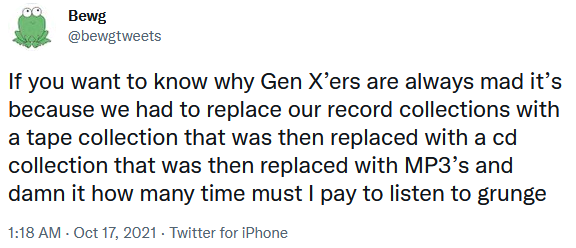
In the Summer of 1995 I bought the CD single of the (still excellent!) Set You Free by N-Trance.2 I’d heard about this new-fangled “MP3” audio format, so soon afterwards I decided to rip a copy of the song to my PC.
I was using a 66MHz 486SX CPU, and without an embedded FPU I didn’t
quite have the spare processing power to rip-and-encode in a single pass.3
So instead I first ripped to an uncompressed PCM .wav file and then performed the encoding: the former step
was done almost in real-time (I listened to the track as it ripped!), about 7 minutes. The latter step took about 20 minutes.
So… about half an hour in total, to rip a single song.

Creating a (what would now be considered an apalling) 32kHz mono-channel file, this meant that I briefly stored both a 27MB wave file and the final ~4MB MP3 file. 31MB might not sound huge, but I only had a total of 145MB of hard drive space at the time, so 31MB consumed over a fifth of my entire fixed storage! Even after deleting the intermediary wave file I was left with a single song consuming around 3% of my space, which is mind-boggling to think about in hindsight.
But it felt like magic. I called my friend Gary to tell him about it. “This is going to be massive!” I said. At the time, I meant for techy people: I could imagine a future in which, with more hard drive space, I’d keep all my music this way… or else bundle entire artists onto writable CDs in this new format, making albums obsolete. I never considered that over the coming decade or so the format would enter the public consciousness, let alone that it’d take off like it did.
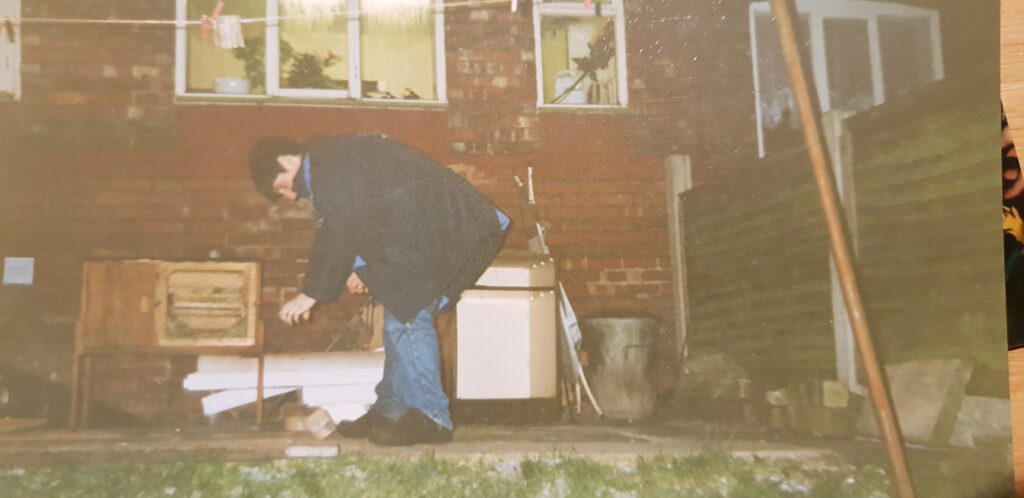
The MP3 file I produced had a fault. Most of the way through the encoding process, I got bored and ran another program, and this must’ve interfered with the stream because there was an audible “blip” noise about 30 seconds from the end of the track. You’d have to be listening carefully to hear it, or else know what you were looking for, but it was there. I didn’t want to go through the whole process again, so I left it.
But that artefact uniquely identified that copy of what was, in the end, a popular song to have in your digital music collection. As the years went by and I traded MP3 files in bulk at LAN parties or on CD-Rs or, on at least one ocassion, on an Iomega Zip disk (remember those?), I’d ocassionally see
N-Trance - (Only Love Can) Set You Free.mp34 being passed around and play it, to see if it was “my”
copy.
Sometimes the ID3 tags had been changed because for example the previous owner had decided it deserved to be considered Genre: Dance instead of Genre: Trance5. But I could still identify that file because
of the audio fingerprint, distinct to the first MP3 I ever created.
I still had that file when I went to university (where it occupied a smaller proportion of my hard drive space) and hearing that distinctive “blip” would remind me about the ordeal that was involved in its creation. I don’t have it any more, but perhaps somebody else still does.
Footnotes
1 I might never have told this story on my blog, but eagle-eyed readers may remember that I’ve certainly hinted at it before now.
2 Rewatching that music video, I’m struck by a recollection of how crazy popular crossfades were on 1990s dance music videos. More than just a transition, I’m pretty sure that most of the frames of that video are mid-crossfade: it feels like I’m watching Kelly Llorenna hanging out of a sunroof but I accidentally left one of my eyeballs in a smoky nightclub and can still see out of it as well.
3 I initially tried to convert directly from red book format to an MP3 file, but the encoding process was too slow and the CD drive’s buffer filled up and didn’t get drained by the processor, which was still presumably bogged down with framing or fourier-transforming earlier parts of the track. The CD drive reasonably assumed that it wasn’t actually being used and spun-down the drive motor, and this caused it to lose its place in the track, killing the whole process and leaving me with about a 40 second recording.
4 Yes, that filename isn’t quite the correct title. I was wrong.
5 No, it’s clearly trance. They were wrong.
Do What You’re Bad At [Video]
This video accompanies a blog post of the same title. The content is basically the same – if you prefer videos, watch this video. If you prefer blog posts, go read the blog post. If you’re a superfan, try both and spot the differences. You weirdo.
Also available on YouTube or on Facebook.
Do What You’re Bad At
This blog post is also available as a video. Would you prefer to watch/listen to me tell you about how I’ve learned to enjoy doing what I’m bad at?
There are a great number of things that I’m bad at. One thing I’m bad at (but that I’m trying to get better at) is being more-accepting of the fact that there are things that I am bad at.

I’m pretty bad in a pub quiz. I’m bad at operating my pizza oven without destroying cookware. I’m especially bad at learning languages. I’m appallingly bad at surfing. Every time my work periodically leans in that direction I remember how bad I am at React. And I’ve repeatedly shown that I’m bad at keeping on top of blogging, to the extent that I’ve periodically declared bankruptcy on my drafts folder.
So yeah, pretty bad at things.
But hang on: that assessment isn’t entirely true.

Being Bad
As a young kid, I was a smart cookie. I benefited from being an only child and getting lots of attention from a pair of clever parents, but I was also pretty bright and a quick learner with an interest in just about anything I tried. This made me appear naturally talented at a great many things, and – pushed-on by the praise of teachers, peers, and others – I discovered that I could “coast” pretty easily.
But a flair for things will only carry you so far, and a problem with not having to work hard at your education means that you don’t learn how to learn. I got bitten by this when I was in higher education, when I found that I actually had to work at getting new information to stick in my head (of course, being older makes learning harder too, as became especially obvious to me during my most-recent qualification)!
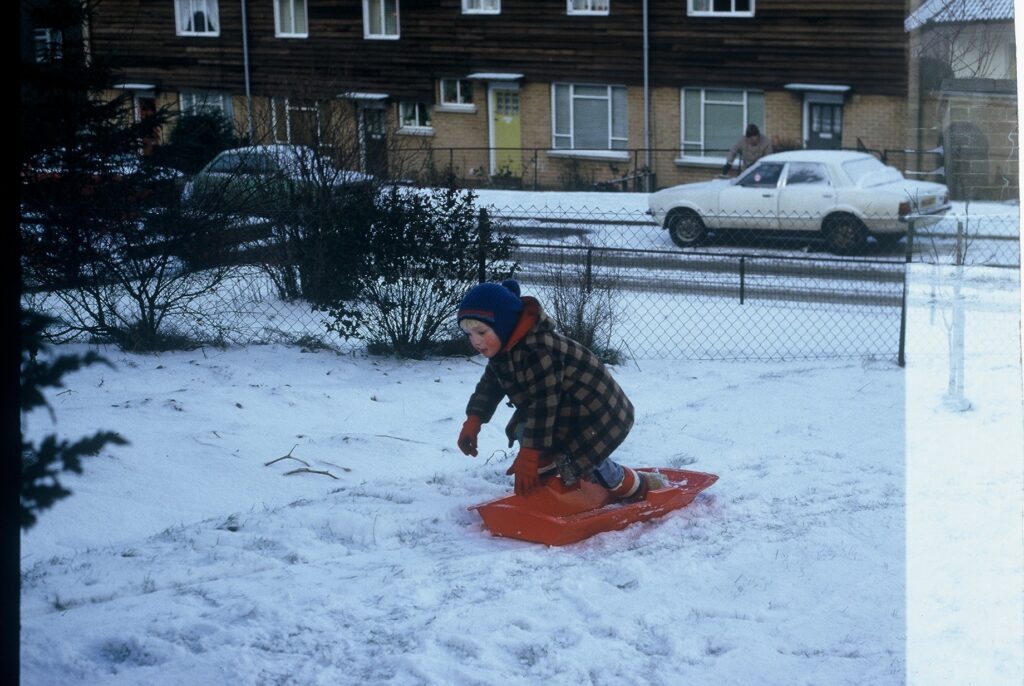
A side-effect of these formative experiences is that I grew into an adult who strongly differentiated between two distinct classes of activities:
- Things I was good at, either because of talent or because I’d thoroughly studied them already. I experienced people’s admiration and respect when I practised these things, and it took little effort to stay “on top” of these fields, and
- Things I was bad at, because I didn’t have a natural aptitude and hadn’t yet put the time in to learning them. We don’t often give adults external reinforcement for “trying hard”, and I’d become somewhat addicted to being seen as awesome… so I shied away from things I was “bad at”.
The net result: I missed out on opportunities to learn new things, simply because I didn’t want to be seen as going through the “amateur” phase. In hindsight, that’s really disappointing! And this “I’m bad at (new) things” attitude definitely fed into the imposter syndrome I felt when I first started at Automattic.
Being Better
Leaving the Bodleian after 8½ years might have helped stimulate a change in me. I’d carved out a role for myself defined by the fields I knew best; advancing my career would require that I could learn new things. But beyond that, I benefited from my new employer whose “creed culture” strongly promotes continuous learning (I’ve vlogged about this before), and from my coach who’s been great at encouraging me towards a growth mindset.
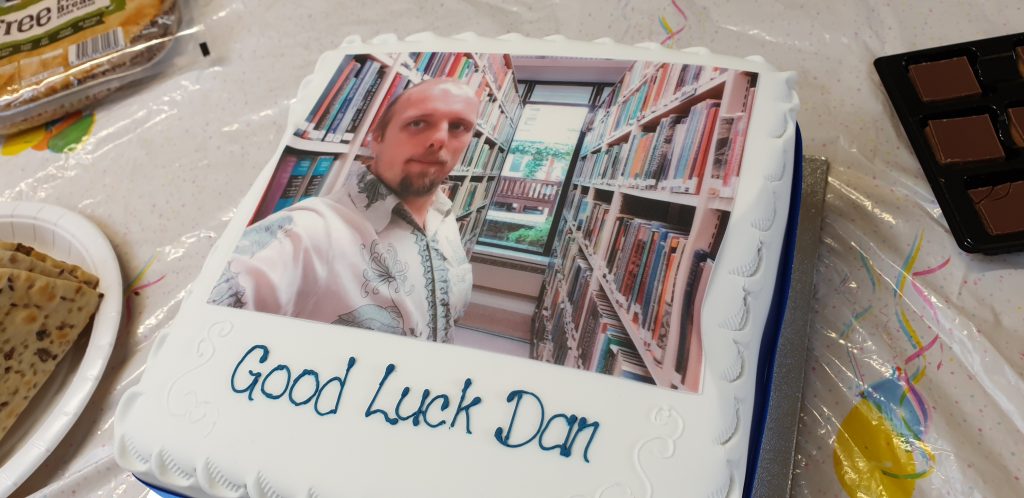
But perhaps the biggest stimulus to remind me to keep actively learning, even (especially?) when it’s hard, might have been the pandemic. Going slightly crazy with cabin fever during the second lockdown, I decided to try and teach myself how to play the piano. Turns out I wasn’t alone, as I’ve mentioned before: the pandemic did strange things to us all.
I have no real experience of music; I didn’t even get to play recorder in primary school. And I’ve certainly got no talent for it (I can hear well enough to tell how awful my singing is, but that’s more a curse than a blessing). Also, every single beginners’ book and video course I looked at starts from the assumption that you’re going to want to “feel” your way into it, and that just didn’t sit well with the way my brain works.

I wanted a theoretical background before I even sat down at a keyboard, so I took a free online course in music theory. Then I started working through a “beginners’ piano” book we got for the kids. Then I graduated to “first 50 Disney songs”, because I know how virtually all of them sound well enough that I’d be able to hear where I was going wrong. Since then, I’ve started gradually making my way through a transcription of Einaudi’s Islands. Feeling like I’d got a good handle on what I was supposed to be doing, I then took inspiration from a book JTA gave me and started trying to improvise.
Most days, I get no more than about 10 minutes on the piano. But little by little, day by day, that’s enough to learn. Nowadays even my inner critic perfectionist can
tolerate hearing myself play. And while I know that I’ll probably never be as good as, say, the average 8-year-old on YouTube, I’m content in my limited capacity.
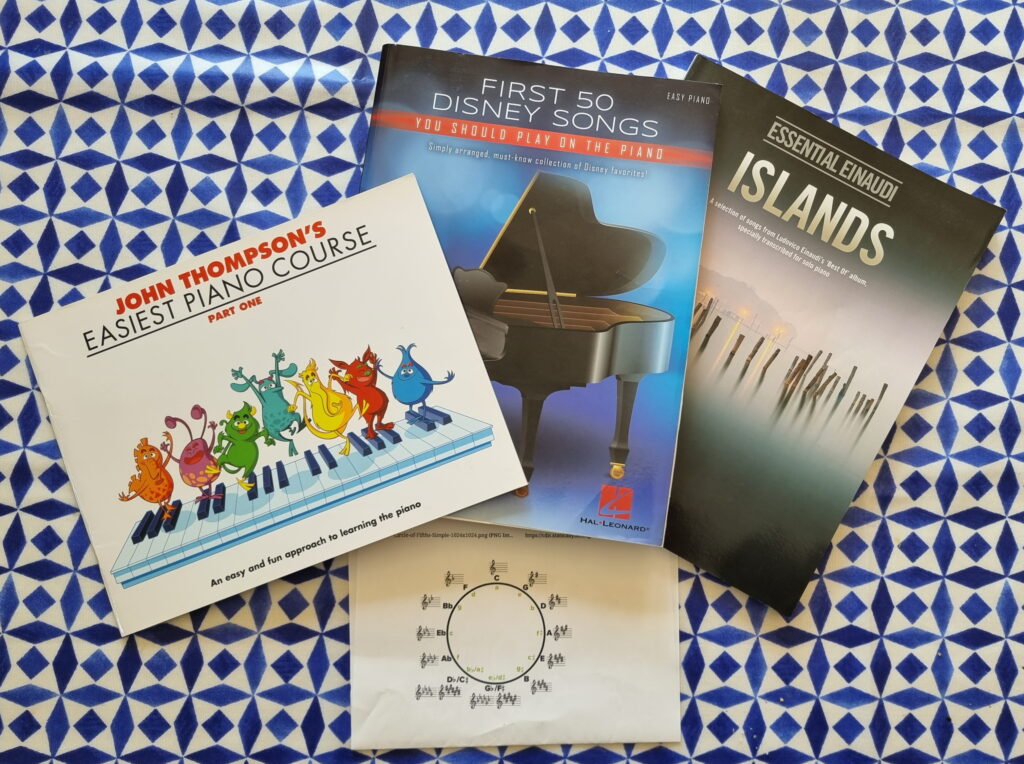
If I’m trying to cultivate my wonder syndrome, I need to stay alert for “things I’m bad at” that I could conceivably be better at if I were just brave enough to try to learn. I’m now proudly an “embarrassingly amateur” pianist, which I’m at-long-last growing to see as better than a being non-pianist.
Off the back of that experience, I’m going to try to spend more time doing things that I’m bad at. And I’d encourage you to do the same.
Octave Compass
This article is a repost promoting content originally published elsewhere. See more things Dan's reposted.
This is cool. Twist the outside dial to transpose the tonal centre of your key. Twist the inner dial to shift the mode of the scale. Turn on- or off- individual tones to shift into more-exotic modes. Use triangles to illustrate the triads of your major, minor, and sustained chords, or add the sixth or seventh with the help of a trapezoid.
The amateur music theorist in me continually struggles to visualise what and why a key is what it is. This kind of thing helps. Plus, what a cool software toy!

